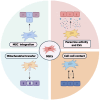Mesenchymal stem cell-based therapy for peripheral nerve injuries: A promise or reality?
- PMID: 40585952
- PMCID: PMC12203133
- DOI: 10.4252/wjsc.v17.i6.107833
Mesenchymal stem cell-based therapy for peripheral nerve injuries: A promise or reality?
Abstract
Peripheral nerve injuries (PNI) that result in nerve gaps represent a major clinical challenge, frequently leading to long-term disability and a diminished quality of life for affected individuals. Despite advances in surgical techniques, functional recovery remains limited, highlighting the need for innovative therapeutic strategies. Mesenchymal stem cells (MSCs) have emerged as a promising avenue for nerve repair due to their regenerative, immunomodulatory, and neuroprotective properties. Thus, this review explored current approaches utilizing MSCs in the treatment of PNI, emphasizing their potential to enhance nerve regeneration and functional recovery. Furthermore, tissue engineering and transdifferentiation of MSCs into Schwann-like cells offer a versatile strategy to optimize therapeutic effects, paving the way for personalized medicine. Nevertheless, challenges persist regarding the clinical application of MSCs in PNI, including transplant safety, delivery methods, optimal dosing, and ethical considerations. A deeper understanding of the mechanisms underlying MSC action in PNI may contribute to more effective treatment protocols in the management of peripheral nerve defects.
Keywords: Cell-based therapies; Extracellular vesicles; Mesenchymal stem cells; Nerve guidance conduits; Nerve regeneration; Regenerative medicine.
©The Author(s) 2025. Published by Baishideng Publishing Group Inc. All rights reserved.
Conflict of interest statement
Conflict-of-interest statement: All authors report no relevant conflicts of interest for this article.
Figures




Similar articles
-
Mesenchymal stromal cells-derived extracellular vesicles in cartilage regeneration: potential and limitations.Stem Cell Res Ther. 2025 Jan 23;16(1):11. doi: 10.1186/s13287-025-04135-6. Stem Cell Res Ther. 2025. PMID: 39849578 Free PMC article.
-
Coaxial Bioprinting of Schwann Cells and Neural Stem Cells in a Three-Dimensional Microenvironment for the Repair of Peripheral Nerve Defects.J Biomed Mater Res A. 2025 Jul;113(7):e37943. doi: 10.1002/jbm.a.37943. J Biomed Mater Res A. 2025. PMID: 40552480
-
Hypoxia-induced metabolic reprogramming in mesenchymal stem cells: unlocking the regenerative potential of secreted factors.Front Cell Dev Biol. 2025 Jun 9;13:1609082. doi: 10.3389/fcell.2025.1609082. eCollection 2025. Front Cell Dev Biol. 2025. PMID: 40552309 Free PMC article.
-
Peripheral Nerve Repair: Historical Perspectives, Current Advances, and Future Directions in Natural and Synthetic Neural Conduits.J Neurosci Res. 2025 Jul;103(7):e70060. doi: 10.1002/jnr.70060. J Neurosci Res. 2025. PMID: 40626373 Review.
-
Bioengineered nerve conduits and wraps for peripheral nerve repair of the upper limb.Cochrane Database Syst Rev. 2022 Dec 7;12(12):CD012574. doi: 10.1002/14651858.CD012574.pub2. Cochrane Database Syst Rev. 2022. PMID: 36477774 Free PMC article.
References
-
- Tusnim J, Kutuzov P, Grasman JM. In Vitro Models for Peripheral Nerve Regeneration. Adv Healthc Mater. 2024;13:e2401605. - PubMed
Publication types
LinkOut - more resources
Full Text Sources

